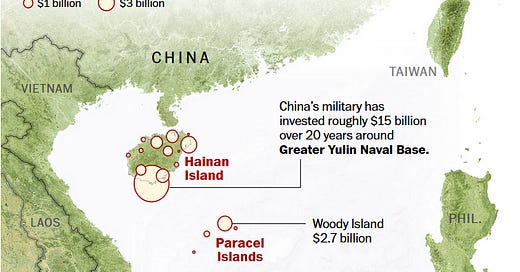Objective: Hainan
But how do Force Design Marines organized and equipped to sink ships win such a campaign?
China's military power has expanded dramatically since the 1990s when China's military was mostly a big mass of proletarian fury designed to absorb and defeat an enemy attack. As recently as 1996 during a Taiwan Strait crisis, China could not even detect the American carriers sent to show support for Taiwan.
Now China has shiny new weapons that could allow China to project power well out to sea. And air and missile forces capable of denying enemy access to areas close to China (area denial, or AD) and increasing the price enemy forces would pay to have access to areas a bit farther out (anti-access, or A2). American allies or foes of China stand in the way of free access to the Pacific and Indian Oceans. But those countries standing in China's way are now vulnerable to attack when the were not before.
China has concentrated a lot of military power on its Hainan Island:
In the past decade, this island roughly the size of Taiwan has become home to China’s most concentrated buildup of modern military power and the launching point for its aggressive forays into the contested waters of the South China Sea.
China has built a lot of infrastructure to project air and sea power out to sea. And a new spaceport. China has air defenses and anti-ship weapons to protect it:
Which means that instead of Bombing Beijing as the expression goes for striking mainland China to harm its power projection capabilities—with all the dangers of strikes on nuclear-armed China's homeland creates—Hainan Island may be a safer, effective, and more narrow focus of American and allied air and missile power in case China starts a war around the South China Sea.
And naval mines could wreck the day for any Chinese squadron that attempts to sortie to do battle.
Indeed, Hainan Island should be a target for large-scale ground combat operations. The Pacific is viewed as a sea theater. But even in World War II the sea combat was centered around land objectives. I wrote about Guadalcanal in this Land Warfare Paper. And I recently highlighted Okinawa in a post about land warfare in the Pacific.
Corps-level ground operations capabilities in INDOPACOM are needed even before you get to the mainland.
But there's a problem. The Marines in the Pacific are transformed into an anti-access/area denial (A2/AD) force. So oddly enough the Marines in the western Pacific are unable to lead such an offensive.
My frustration over the lost opportunity to use the Navy Expeditionary Combat Command for the A2/AD mission while more conventional Marine units provide security for them is all the greater. I noted this option many years ago in Proceedings when I suggested a APD based on converted old Perry frigates to move company-sized A2/AD detachments around.
NOTE: The images are from the linked Washington Post article.





